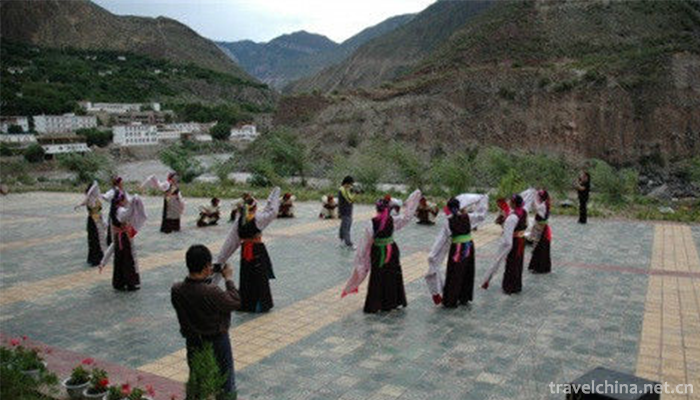Mangkang Trichord Dance
Sanxian Dance originated in Quzika Township, Mangkang County, Changdu District. It has the unique charm of simplicity, elegance, melodiousness and ease, and is deeply loved by the masses. Passengers played an important role in the spread of Sanxian, making Sanxian Dance a very famous dance in southeastern Tibet and at the junction of Tibet, Sichuan and Yunnan.
In June 2008, the Mangkang Sanxian Dance declared by Mangkang County of Tibet Autonomous Region was listed in the second batch of national intangible cultural heritage list with the approval of the State Council.
Heritage serial number: 683 III-86.
historical origin
Sanxian Dance originated in Daxu Village, Quzika Township, Mangkang County. According to textual research, it has a long history of four or five hundred years. So far, besides its wide spread in the township, it is also well-known in the surrounding areas. Sanxian Dance is accompanied by Sanxian Qin. It is said that the head of the piano is the head of the dragon, the body of the piano is the backbone of the dragon, and the strings are the tendons of the dragon. Today's Sanxian Qin is made of pure wood.
artistic characteristics
The performance of tri-string dance is to gather men and women to dance and sing, with beautiful lyrics, melodious rhythm, fast and slow. Music is characterized by simplicity, brightness and fluency in singing. Not limited by the number of people, venues and other constraints, men and women singing together, singing while dancing, generally in the melodious and gentle music, smooth and happy performance in the midfield, rising and enthusiastic end, are to avoid disasters and dispel disasters, celebrate harvest, wish good luck as the main content.
Inheritance status
But nowadays, Sanxian Dance is facing the situation of losing its heritage. After careful arrangement and excavation by a large number of literary and artistic workers and old folk artists in the folk art troupe of Mangkang County, this unique art of Mangkang County has shown its former elegance again. It is said that the original dance has 13 programs, but only 7 are still handed down. After liberation, the tri-string dance won the audience's praise in the literary and artistic performances of the founding Congress in Changdu area on the occasion of the founding of Tibet Autonomous Region in 1965. Today, nearly 200 artists can dance seven dances that have been passed down to this day. At present, driven by the local tourism industry, with a certain mass base, it has gradually attracted tourists and literary and artistic circles both inside and outside the region. This unique art has a growing influence in adjacent provinces and regions. Especially with the further implementation of the Party's national policy and the literary and artistic policy of "letting a hundred flowers blossom", the Mangkang Quzika Trichord Dance has gradually become a relatively complete performance system with its vigorous vitality and extremely deep mass foundation, radiating the unique glory of the unique culture of southeastern Tibet, and has made due contributions to the promotion and promotion of the socialist spiritual civilization construction.
Inheritance significance
Quzika Trichord Dance in Mangkang County has a long history, ancient magic, unique form, strong national style, rich plateau characteristics, rich content of singing and dancing, and its singing and dancing tradition is precious.

0 Questions
Ask a Question
Your email address will not be published.